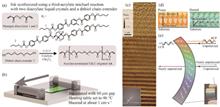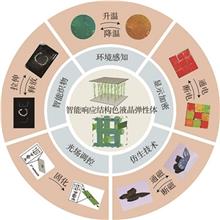Photoresponsive chiral liquid crystal materials, as a type of soft matter with self-assembly and entropy-driven ordering properties, exhibit excellent optical modulation of helical structures and are widely used in optical anti-counterfeiting, optical coding, and laser engineering. By incorporating chiral photoswitches into liquid crystal systems, light-induced chiral conversion can be effectively harnessed to remotely control the self-assembled helical structures of the liquid crystal materials. Currently, azobenzene, molecular motors, and diarylethene are widely utilized as chiral photoswitches in liquid crystal systems. These compounds exhibit weak stimulus and strong response control properties, highlighting their broad application prospects.This paper focuses on the structural design concepts of these three types of chiral photoswitches and summarizes the unique properties exhibited in light-modulated liquid crystal helical structures, including the reversible optical control of parameters such as helical structure pitch size and direction.Finally, the light-responsive flexible liquid crystal materials constructed using these photoswitches demonstrated their ability to achieve changes in color and shape through light manipulation, showcasing potential application in information storage, anti-counterfeiting, soft robotics, and wearable devices, along with an outlook on future developments in this field.
Chiral liquid crystals is a unique photonic material, which can be generally divided into 1D cholesteric liquid crystals and 3D blue phase liquid crystals. Benefiting from the intrinsic periodically arranged nanostructures, chiral liquid crystals not only has the optical properties that ordinary liquid crystals does not have, such as selective reflection, optical activity and circular dichroism, but also can quickly and sensitively respond to external environmental conditions, which are widely used in the fields of advanced display, dynamic anti-counterfeiting, information encryption, intelligent fabrics and so on. In recent years, with the vigorous development of 3D printing technology, researchers have developed a variety of printable chiral liquid crystal inks, prepared chiral liquid crystal materials with complex geometric structure, multi-function, and multi-stimulus-response, and further studied the potential application value of 3D printing chiral liquid crystal. In this paper, the self-assembly mechanisms of chiral liquid crystals based on 3D printing technology are systematically reviewed, such as shear-induced orientation self-assembly, anisotropic deswelling self-assembly, critical colloid concentration self-assembly, and various stimulus-responsive chiral liquid crystal materials and chiral liquid crystal functional materials with fluorescent luminescence based on 3D printing technology are mainly introduced. Finally, we summarized the prospects and potential challenges of 3D printing chiral liquid crystal materials.
Blue-phase liquid crystals are self-assembled three-dimensional soft photonic crystals with a wide range of applications in the fields of sensing and display, information encryption, anti-counterfeiting, and optical devices. However, the research on the blue-phase phase transition is not sufficient. In this paper, phase transition process was investigated for the single-domain BPⅡ to BPⅠ (a wide temperature interval 2.5 ℃) based on optical and structural features, and the mechanism of phase transition behaviors at each stage was elucidated by using the crystal nucleation and growth theory. BPⅡ-BPⅠ coexistence stage was proved by the bimodal peaks of the reflectance spectra and the superposition of circles and quadruple arcs in the Kossel diffraction pattern, which indicated simple superposition of the BPⅡ and BPⅠ phase state. The lamellar growth structures of the BPⅡ, BPⅡ-BPⅠ, and BPⅠ phases were observed using polarized light microscopy and low-voltage scanning electron microscopy. BPⅠ was found to nucleate and grow epitaxially from the edge dislocations of BPⅡ, and its phase transition process transformed layer by layer from top to bottom of the cell. The edge dislocations and screw dislocations moved and merged at the BPⅠ stage, transforming the texture into a concentric ring. This study is of great significance both for enrich the theory of blue phase transition and guiding the preparation of large-area single-domain blue phases.
Structural-colored liquid crystal elastomer (SLCE) is a class of crosslinked polymer networks combining optical structural colors and rubber-like elastic properties. Structural-colored liquid crystal elastomer devices produce vibrant and durable colors by Bragg reflection from their internal periodic submicron structures. In recent years, the development of structural design and manipulation techniques has led to a significant increase in the versatility and tunability of structural-colored liquid crystal elastomer, which has driven its development in the fields of materials science and optics. In this paper, we briefly introduce the basic properties of cholesteric liquid crystal elastomer and blue phase liquid crystal elastomer, followed by focusing on an overview of their research progress in the fields of environment sensing, display encryption, bionics and smart fabrics. Finally, a further summary and outlook are given for the challenges and application prospects of structural-colored liquid crystal elastomer in practical applications.
As the demand for information capacity and color quality continues to increase, color optical holography has garnered significant attention and is now widely applied in areas such as color displays, augmented reality (AR)/virtual reality (VR) and information encryption. However, most current color holography techniques are based on metasurfaces and similar systems, achieving color holography in soft matter, specifically those represented by liquid crystals, remains challenging. In this study, we propose a bi-chiral cholesteric liquid crystal (CLC) superstructure, which enables circular polarization multiplexed color holography through the liquid crystal photoalignment and Bragg reflection band modulation techniques. By employing washout and refill steps involving a surface-initiated polymerization process, alongside liquid crystal photopatterning technology, we achieve spin-decoupled geometric phase, enabling the independent phase modulation of left- and right-handed circularly polarized light. The geometric phase and the resultant holographic image are generated exclusively when the incident light’s polarization and wavelength precisely match those of the CLC. Through the independent control of Bragg reflection bands in left- and right-handed CLCs, multiple holographic images are successfully generated on the same diffraction plane, resulting in the tunable and multiplexed color holography. The proposed spin-decoupled color holography via bi-chiral liquid crystal superstructures holds great promise in advanced displays, optical encryption and multi-channel communication.











